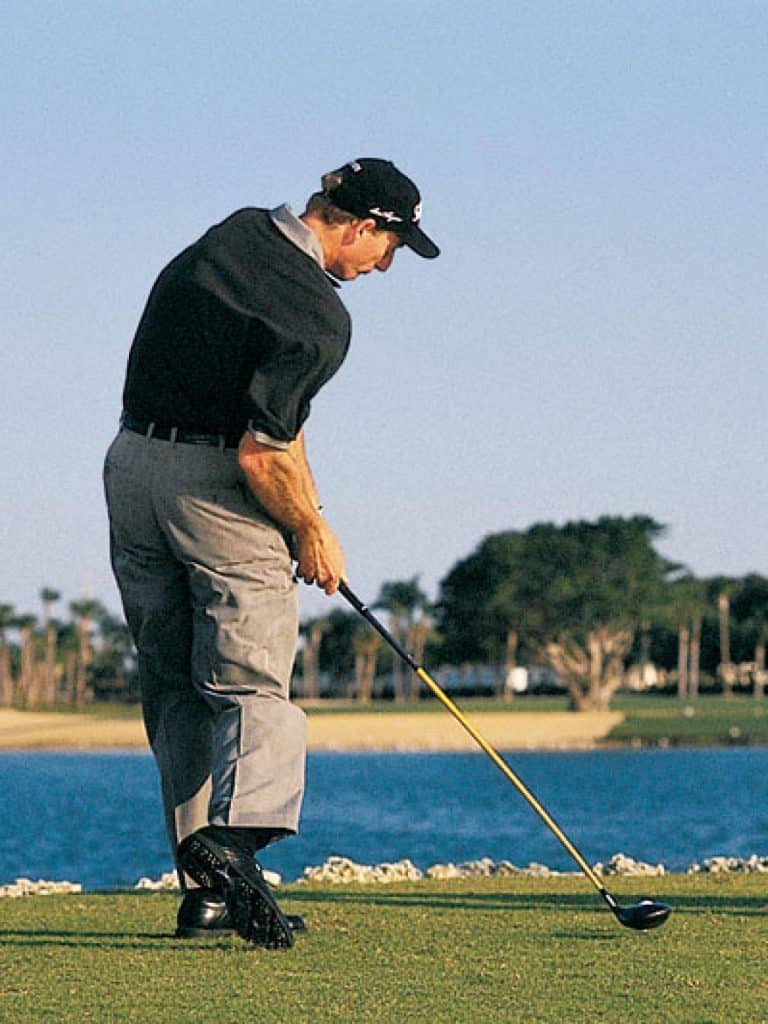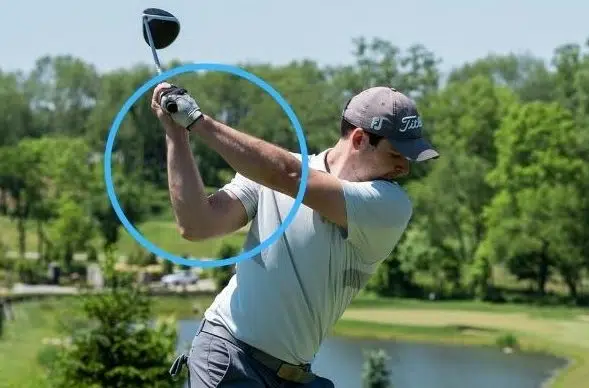If you’ve ever heard the saying “golf is a left-sided” game, then you’re probably wondering how big of a role your right arm should play in your swing.
The answer: a lot more than you might think.
If you’ve ever had golf lessons – if you’re a beginner, I highly recommend you do – it’s likely your teaching pro has mentioned that it’s your left arm, and left side that should be doing the bulk of the work in the swing (for a right-handed player).
This is largely true: your left arm has a big influence on swing plane and path, while the clearing of your left hip, left part of your chest and left shoulder gets you open and greatly contributes to power and accuracy.
So then, what does the right arm do in the golf swing?
In the golf swing, the right arm has two main purposes: to help control the clubface, and to generate power. The right arm also greatly assists in keeping the club travelling on plane. Moving the right arm correctly throughout the swing can improve your game dramatically.
In this article, I’ll explain how the right arm should behave in your golf swing, offer some tips and drills to practice it, and also answer some other related questions regarding the role of the right arm.
Table of contents
What should my right arm do in the golf swing?
In golf, the right arm and elbow should stay connected with your ribs in both the backswing and downswing. At impact, your right arm and elbow should be relaxed and bent – only extending into a straight position after striking the golf ball.
One of the biggest mistakes you’ll see amateurs make is extending their right arm and releasing their lag too early as they move into impact.
This ‘flipping’ motion – often caused by a stalling of the hips – causes them to stand the club up vertically and lose forward shaft lean, leading to poor compression and inconsistent strikes.
It’s for these reasons that ensuring the right arm is behaving correctly is essential if you want to be a good golfer.
Below, I’ve laid out a step-by-step checklist you should follow the next time you’re at the driving range, or practicing alone on the course, if you want to improve how your right arm moves in your swing.

How to move your right arm in the golf swing
There are four key checkpoints you should focus on when it comes to your right arm in the golf swing: the backswing, downswing, at impact, and after impact.
Let’s take a look at each in more detail.
Step 1: How the right arm moves in the backswing
In the takeaway, your right arm should be straight yet relaxed as it works away from the ball in unison with your left arm.
Once the club reaches a parallel position to the ground, the right arm should begin to fold and start moving upwards towards the top of the backswing.
At the completion of your backswing, your right arm should still remain slightly bent and connected with your ribcage, while your right hand and wrist should be bent backwards and pointed towards the sky (as if you were balancing a pizza box on it).
A great way to practice this is by using the Total Golf Swing Trainer, which is designed to help you perfect your right wrist angle.
Step 2: How the right arm moves in the downswing
The downswing is where many amateurs will make mistakes with their right arm and elbow – but it’s usually a pretty obvious fix.
For a long time, I thought you had to keep your right elbow stiff and tucked into your ribcage as you started rotating your hips – however, doing this will either cause you to move the club outside the swing plane (in an over-the-top action), or dump it under the swing plane (leading to hooks and blocks).
Instead, as you begin the downswing, you should allow your right arm to unfold as you turn – this will let you shallow the club far more effectively, dropping it into the slot, and setting it up for an ideal impact position.
Golf pro Zach Allen explains this extremely well in the video below:
Step 3: Keep your right arm bent at impact
This is the step that separates the average golfers from the elite golfers.
If you freeze the best players in the world at the moment of impact, the overwhelming majority of them will have a slightly bent right arm as the club strikes the ball (I explain this more in my article about the importance of maintaining side bend).
By comparison, many mid-to-high handicappers will already have their arms fully extended as their club makes contact with the ball, which leads to poor compression, inconsistency contact and accuracy issues.
The best way to practice keeping a bent right arm and elbow is by using the Snitz Golf Spinner Swing Motion Trainer, which will help you hone the correct feels when you warm-up before a round or range session.
Making repeated swings using this device will soon teach your body how to move correctly in order to deliver a bent right arm at impact.
Step 4: Extend your right arm after impact
The last piece of the puzzle is extending your right arm after you’ve struck the ball.
Delivering a bent elbow right up until the point of impact stores all the necessary lag and power required to bomb the ball down the fairway, and straightening your right arm through the ball is how you release that energy.
It’s important to only extend your right arm after you strike the ball, not before it – as doing so too early will waste all the natural speed you’ve created in the swing up until that point.
A great way to practice this is by hitting shots using only your right arm and focusing on getting the shaft leaned forward – and your hands in front of the ball – at impact.
This will train you to clear your hips out of the way to allow the correct delivery of the club at impact.
Other Frequently Asked Questions
Should my right arm be tucked in the golf swing?
Your right arm should stay connected with your torso in the takeaway and backswing, while remaining tucked into your ribcage during the downswing. However, as you start the downswing, you must remember to unfold your right elbow to allow the club to travel down the swing plane.
Holding a bent right elbow for too long will cause the clubhead to move either underneath or over-the-top of the plane as you rotate into impact, causing either blocks, hooks or slices.
Should the right elbow stay close to the body in the backswing?
In golf, your right elbow and arm should stay connected to your ribcage as you commence the takeaway and move to the top of the backswing. If you placed a handkerchief under your right armpit, it should remain there from the beginning to the end of the swing – only dropping to the ground as you complete your follow through and hold your finishing pose.
Should the right arm fold in the backswing?
Your right arm should only begin to fold at the elbow once the club has reached a parallel position to the ground in the takeaway. From there, the club should begin moving in an upwards fashion and your right elbow should fold even further to allow the club to reach an ideal backswing position.
At the top of the backswing, your right arm should be positioned as if you were balancing a pizza box on the palm of your hand.
Which arm is more dominant in the golf swing?
Golfers tend to use their dominant throwing hand more in the golf swing – whether that be their left or right hand. Just because a player addresses the ball in a right-handed stance does not necessarily mean their right hand is more dominant than their left (and vice versa for players who take a left-handed stance at address).
But traditionally, the lead arm has more influence on guiding the club through impact, while the trail arm delivers more power through the shot.
Final message
Your right arm has a greater role in your golf swing than you might have originally thought.
Ensuring that it remains bent at the point of impact with the ball, and only extending it straight after contact is made are the key things to remember when it comes to using your right arm in golf.
If you can master these technical elements then you’ll notice immediate improvement in your ball-striking.


